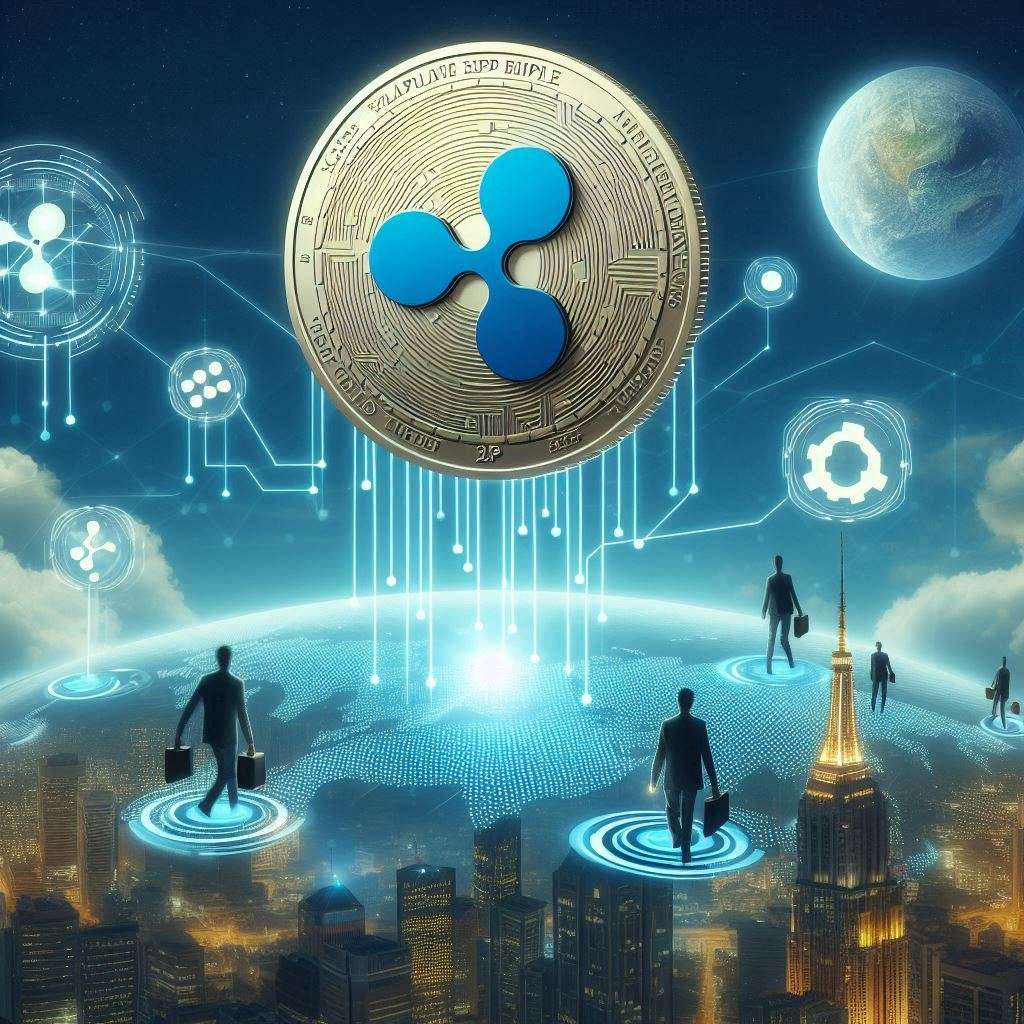Latest News
- XRP Eyes 50% Breakout Versus Bitcoin as Technicals Mirror 2024 Setup
- Crypto Analysts Are Eyeing This $0.003 Token With Bigger Potential Than Bitcoin, ETH, and XRP!
- XRP Funding Rate Surges Amid Crypto Market Sell-Off: What’s Happening?
- XRP Price at $2.05 Represents 44.57% Drop From All-Time High: Can It Surge Today?
Current Price
The current price of XRP is $2.04230
Introduction
Imagine trying to send a postcard from New York to Tokyo in under five seconds—that’s fundamentally what Ripple Blockchain (XRP) accomplishes for cross-border payments.
Founded in 2012, Ripple aims to revolutionize the traditional banking system by offering near-instantaneous and low-cost transactions.
With a unique consensus algorithm, XRP handles up to 1,500 transactions per second, boasting partnerships with over 300 financial institutions.
However, concerns about centralization and ongoing legal battles with the SEC mean you should weigh the pros and cons carefully.
So, what makes Ripple a game-changer, and what hurdles does it face?
Let’s find out in this review…
Quick Overview
- Ripple enables real-time global payments with a unique consensus mechanism, enhancing transaction speed and reducing costs.
- XRP transactions settle in 3-5 seconds and can handle up to 1,500 TPS, offering high scalability.
- Ripple has strong security features with cryptographic algorithms and a consensus protocol ensuring transaction integrity.
- Ripple collaborates with over 300 financial institutions, including Santander and American Express, to streamline global transactions.
- Regulatory compliance and strategic partnerships enhance Ripple’s market credibility and expand its ecosystem.
What Is Ripple?
Here’s a great beginners guide to Ripple (XRP) video:
Ripple, a dynamic force in the blockchain landscape, isn’t just another cryptocurrency; it’s a real-time gross settlement system, currency exchange, and remittance network.
To truly understand Ripple, you need to look at its history and technology.
Founded in 2012 by Chris Larsen and Jed McCaleb, Ripple aimed to create a frictionless experience for global transactions. Unlike traditional cryptocurrencies, Ripple’s technology leverages a consensus ledger and a unique consensus mechanism, setting it apart from proof-of-work or proof-of-stake systems.
One of Ripple’s key advantages is its speed and efficiency in transaction processing. Transactions settle in just 3-5 seconds, compared to Bitcoin‘s 10 minutes or more. This speed is essential for financial institutions that require quick and reliable settlements.

The Ripple community is robust, with active developer engagement and partnerships with over 300 financial institutions globally. This network effect amplifies Ripple’s utility and adoption.
Looking ahead, the Ripple future seems promising. Its focus on regulatory compliance and ongoing technological advancements positions it well to potentially revolutionize financial systems worldwide.
The combination of historical performance, cutting-edge technology, and strong community support makes Ripple a formidable player in the blockchain ecosystem.
How XRP Works
Understanding how XRP works involves delving into its unique consensus algorithm and the role of its native digital asset, XRP, within the Ripple network.
At the core of XRP ledger technology is the consensus mechanism, which replaces traditional proof-of-work or proof-of-stake systems. Unlike other blockchains, Ripple’s consensus mechanism guarantees transaction validation through a network of trusted validators. This design markedly reduces the energy consumption and time needed for the XRP transaction process.
XRP security features are robust, leveraging cryptographic algorithms to safeguard transaction integrity and user privacy. Each transaction undergoes rigorous validation, guaranteeing it meets all protocol requirements. This makes the network resilient against double-spending and other common blockchain vulnerabilities.

Scalability solutions are another strong suit of XRP. The network can handle up to 1,500 transactions per second (TPS), considerably outpacing Bitcoin and Ethereum.
The XRP ledger’s architecture allows for seamless integration with various financial institutions, making it a preferred choice for cross-border payments.
Key Features
Delving into the key features of XRP, you’ll find a robust blend of efficiency, security, and scalability that sets it apart from other blockchain technologies.
One of the most compelling aspects of XRP is its exceptional transaction speed. XRP transactions settle in just 3-5 seconds, a stark contrast to Bitcoin’s 10-minute average. This rapid confirmation time directly addresses scalability solutions, enabling the network to handle up to 1,500 transactions per second.
Security measures are another vital feature. XRP employs a consensus protocol rather than traditional mining, reducing energy consumption and increasing network integrity. This consensus model allows for swift validation without compromising security, ensuring that transactions are both rapid and secure.
XRP’s governance model is designed to foster user adoption and decentralization. It utilizes a unique node list (UNL) that’s regularly updated, ensuring that no single entity gains control over the network. This decentralized approach encourages trust and transparency, essential factors for widespread user adoption.
Here’s a closer look at the key features:
- Transaction Speed: Settles transactions in 3-5 seconds.
- Scalability Solutions: Handles up to 1,500 transactions per second.
- Security Measures: Utilizes a consensus protocol for swift and secure validations.
This combination of features makes XRP a formidable player in the blockchain space.

Real-World Applications
Exploring the real-world applications of XRP reveals its potential to revolutionize various industries through its high efficiency and robust security features. One primary use case is in cross border payments. Traditional systems often incur high fees and prolonged transaction times, but XRP enables near-instantaneous transfers with minimal costs. This makes XRP a game-changer for remittance solutions, greatly benefiting individuals in developing countries who rely on sending money home.
In terms of financial inclusion, XRP can democratize access to banking services. Many unbanked populations can leverage XRP for secure and affordable transactions, bypassing the need for traditional banking infrastructure. This is particularly impactful in regions where access to financial services is limited.
Furthermore, XRP has promising applications in decentralized finance (DeFi). By integrating with various DeFi platforms, XRP can facilitate smooth and rapid transactions, enhancing liquidity and reducing counterparty risks.
This capability extends to smart contracts and decentralized exchanges where speed and security are paramount.
Pros and Cons
When evaluating Ripple Blockchain (XRP), it’s essential to weigh both its advantages and disadvantages to form a thorough view. Ripple’s technology is lauded for its transaction speed, boasting near-instant transfers, which greatly outpace traditional financial systems. Additionally, the strong community support surrounding XRP fosters continuous development and adoption.
However, it’s important to acknowledge several drawbacks:
- Security Concerns: While Ripple’s centralized nature can be advantageous for control and efficiency, it also introduces potential vulnerabilities. Centralization can make it a more attractive target for cyberattacks.
- Market Volatility: Like most cryptocurrencies, XRP is subject to considerable market volatility. Price fluctuations can pose risks for investors and institutions looking for stability.
- Regulatory Challenges: Ripple has faced numerous regulatory challenges, particularly in the U.S. The ongoing legal battles with the SEC create uncertainty, potentially impacting its market position and broader adoption.
Despite these issues, Ripple’s strengths in transaction speed and community support present compelling reasons for its consideration. A balanced view, weighing both its pros and cons, will help you make an informed decision regarding Ripple Blockchain (XRP).

Partnerships & Collaborations
Ripple Blockchain (XRP) has strategically forged numerous partnerships and collaborations, greatly enhancing its ecosystem and market reach.
By forming Ripple partnerships with over 300 financial institutions, Ripple has established a robust network that leverages its technology for cross-border payments.
Notable financial collaborations include Santander, American Express, Clear Junction, and Standard Chartered, which use RippleNet’s technology integrations to streamline transaction processes and reduce costs.
These strategic alliances aren’t just limited to financial entities. Ripple has also partnered with technology firms to enhance its blockchain infrastructure. For instance, the collaboration with SBI Holdings in Japan has facilitated a significant boost in XRP’s liquidity and adoption in Asian markets.
In addition, the integration with MoneyGram has showcased Ripple’s capability to handle high-volume remittances, reinforcing its position in the payments industry. Ripple’s global outreach extends beyond traditional banking.
Their partnerships with institutions like the University Blockchain Research Initiative (UBRI) emphasize Ripple’s commitment to fostering innovation and research in blockchain technology. The critical analysis reveals that these collaborations haven’t only bolstered Ripple’s market credibility but have also paved the way for broader acceptance and utility of XRP in various sectors.
This strategic approach has certainly positioned Ripple at the forefront of blockchain technology adoption.
Frequently Asked Questions
How Is XRP Different From Other Cryptocurrencies Like Bitcoin and Ethereum?
You’ll find XRP stands out with its real-time liquidity management, faster transaction speed, and diverse use cases. Unlike Bitcoin and Ethereum, XRP also navigates the regulatory environment better, contributing to lower market volatility and increased stability.
What Are the Legal Challenges Faced by Ripple and Xrp?
You’re dealing with the SEC lawsuit, creating regulatory implications and market volatility. These legal battles affect investor sentiment and pose compliance challenges. Regulatory clarity is essential for XRP to stabilize and regain investor confidence.
Can Individuals Mine XRP Like Bitcoin?
Imagine mining XRP like Bitcoin, but you can’t. The XRP mining process doesn’t exist. Cryptocurrency mining differences arise from Ripple’s pre-mined supply, leading to lower energy consumption. This enhances Ripple network security and impacts market demand.
How Does Ripple’s Consensus Algorithm Work?
Ripple’s consensus mechanism relies on validator nodes agreeing on transactions, enhancing transaction speed and network scalability. This security model guarantees quick validations without mining, making it efficient and secure for high-volume, real-time transactions.
What Are the Future Developments Planned for Ripple and Xrp?
You’re seeing XRP adoption trends skyrocketing, with Ripple partnerships growth expanding globally. The XRP regulatory outlook remains cautiously optimistic. Future roadmap insights promise cutting-edge Ripple technology advancements, enhancing transaction efficiency and opening new doors for financial innovation.
Conclusion
In conclusion, Ripple’s XRP offers a modern-day “Silk Road” for cross-border payments, blending speed and efficiency.
Its unique consensus algorithm and robust partnerships testify to its technical prowess, though centralization concerns and SEC disputes cast shadows.
As with any investment, weigh its innovative strengths against potential risks.
Ripple’s journey reveals a classic tale of ambition and adversity, inviting you to critically assess its future in the financial landscape.

